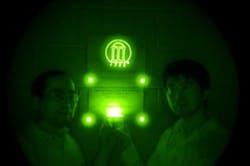Near-IR phosphor that emits for weeks promising for cancer detection
While persistent phosphors (glow-in-the-dark materials) for the visible region are everywhere, persistent IR phosphors have been difficult to develop. Now, researchers at the University of Georgia (Athens, GA) have created a near-IR phosphor that has an afterglow of up to two weeks after a one-minute exposure to sunlight. The material can be made into nanoparticles that bind to cancer cells, as well as the potential for other biomedical applications.
The researchers created a series of chromium-doped zinc gallogermanate phosphors that exhibit strong emission at somewhere between 650 to 1000 nm, with the peak wavelength determined by composition.
"When you bring the material anywhere outside of a building, one minute of exposure to light can create a 360-hour release of near-IR light," says Zhengwei Pan, one of the researchers. "It can be activated by indoor fluorescent lighting as well, and it has many possible applications."
The time period of light emission for the trivalent chromium ion used in the emitter is normally short, typically on the order of a few milliseconds. The innovation in Pan's material is that its chemical structure creates a labyrinth of traps that capture excitation energy and store it for an extended period. As the stored energy is thermally released back to the chromium ions at room temperature, the compound persistently emits near-IR light.
Pan and researchers Feng Liu and Yi-Ying Lu spent three years developing the material. Initial versions emitted light for minutes, but the researchers extended this time to days, and finally to weeks. "Even now, we don't think we've found the best compound," Pan says. "We will continuously tune the parameters so that we may find a much better one."
The researchers placed the material in fresh water, salt water, and even a corrosive bleach solution for three months and found no decrease in performance.
For more information, please visit http://www.nature.com/nmat/journal/vaop/ncurrent/full/nmat3173.html.
-----
Subscribe now to Laser Focus World magazine; it's free!
